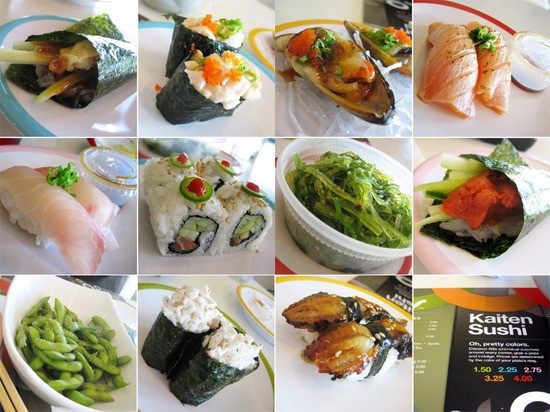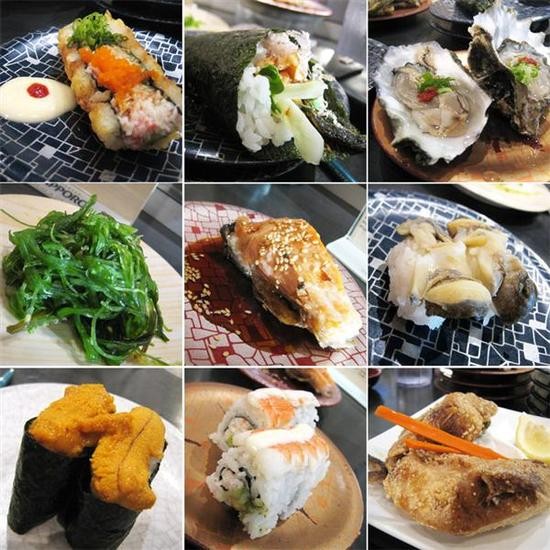
On this episode of Dueling Dishes we pit two revolving sushi houses. Sushilicious is the newcomer; Kaisen is the long-established contender. But this week, we're not comparing just a single dish between the two of them. Since one dish can literally constitute just one bite, dining at revolving sushi joint–more than any other restaurant–is about the cumulative experience of those bites.
]
The scene:
Sushilicious is spacious, blindingly colorful, and gleaming with plastic. It's as if an Apple store adopted the pastel-hued design scheme of a Yogurtland. The servers in matching T-shirts employ actual iPod Touches to take down your order and tally up your finished plates. From any seat in the store, you see the chefs preparing your food. Though it's busy on weekends, weeknights are a slower and quieter dining experience.
By contrast, Kaisen is more traditional-looking, dark, cramped and buzzing with more people than a Tokyo subway platform. Even on weeknights, there's frequently a wait. Unless you are sitting directly in front of them, you won't see the chefs. The waitresses who shuffle back and forth from the kitchen take orders and tally the stacks of colored plates the old-fashioned way with a pen all while wearing constricting kimonos.
The food:
Sushilicious' sushi features cutesy titles like “The Roll Formerly Known As California” and “Sushicalifragilisticexpialidocious”, each with permanent pedestals on the conveyor belt. You notice that there's a set game plan here. Those pre-named pedestals are almost a fill-in-the-blank script–a sushi madlib, if you will. They are refilled as needed with exactly what's needed to fill them.
Nearly all the pieces are dainty bites, carefully sculpted and constructed. I saw one sushi chef take his sweet time in molding his roll, as if he was being judged for presentation. Rice for their nigiri is portioned to make up less than a mouthful per serving. The fish that goes over the top is sliced sometimes too thinly.
One roll has a micro slice of an unidentified chili pepper and dot of Sriracha topping it, both producing a wallop of hotness I didn't expect but enjoyed. The scallop nigiri is surprisingly refined with the bivalve chopped up into small tender bits, lubed in light mayo and graced with a dollop of orange fish roe. Hand rolls are sauced nicely, flavor-packed and crunchy–one of the things you have to order off the menu. Most of the rest of your meal, you take off the belt.

Kaisen's rolls, by contrast, register as full mouthfuls. There are deep-fried California rolls, bifurcated lengthwise with a puddle of mayo-dipping sauce off to the side. Others have shrimp draped over the tops. But what you'll notice most about Kaisen is that none of what you see rolling past you has a name. Often, you won't have any idea what an item is until you eat it. It's almost as if it's a sushi free-for-all. The chefs seem to riff like an improvisational jazz soloist. Sometimes it makes sense, sometimes it doesn't. I saw a piece of broiled salmon that looked good at first, but determined after I took a bite that it would've been better if it were hot instead of tepid. Others like the clam nigiri crunches as it should.
Your sushi savvy and judgment is the only thing you have pick out what looks good and leave alone what you suspect has been rolling around a while. Hand rolls, raw oysters, and the uni nigiri are just a few items you have to order from the menu by transcribing them on a sheet you send off by way of the train. And though the oysters were served at room temperature, and the uni wasn't particularly sweet, the hand rolls are crisp and more importantly, usually discounted on special.
But by far the most compelling reason to come to Kaisen is the deep fried hamachi collar. This is an item you won't find on the conveyor belt, nor on the menu. You have to ask for it specifically. And it will be the most expensive thing you order all night, easily twice the price of the highest priced conveyor plate. But as any connoisseur will tell you, this boomerang-shaped piece of the carcass nearest near the gills is the best part of the fish. And Kaisen does it right: cooked to a piping-hot, golden sheen under a light batter so that every piece that isn't bone is crispy as a chip or soft as whipped butter.
The prices:
As with all revolving sushi restaurants, prices are designated by the color of plate. Here's the breakdown on the Sushilicious pricing scheme: $1.50, $2.25, $2.75, $3.25, $4.00.
But that doesn't begin to tell the story. There's a nonsensical way in the way things are priced at Sushilicious. Why, for instance, is the seaweed salad $4? That's almost twice as much as the scallop nigiri–a bargain by comparison at $2.25. And on my trip, I had the choice of the puny portion of already-cold edamame for $1.50 from the sushi belt; or the $1.25 freshly-made-to-order and steaming hot edamame that came in a big bowl as wide as my face. Since I'm smart like that, I took the latter.
Kaisen, in contrast, is more logical in its pricing scheme. A plate of similar (albeit smaller) seaweed salad is priced at $0.99.
Other plates range from $1.25, $1.75, $2.25, $2.75, and $3.50. All prices are appropriate for the portion size and make of fish.
Both restaurants feature discounted specials. Kaisen offers more items discounted nightly, often at half off regular prices. Sushilicious rotates their hand roll to be on special on specific weeknights for only a nominal price reduction.
The winner:
After much deliberation, considering all the points I made above, I have to conclude that I can't pick a winner here. To be honest, I'd go back to either one this instant…and I just might. Hot weather = sushi weather.
Kaisen Sushi Restaurant, 3855 South Bristol Street, Santa Ana, CA 92704-7426, (714) 444-2161.
Sushilicious, 15435 Jeffrey Road #119, Irvine, CA 92618, (949) 552-2260.
Before becoming an award-winning restaurant critic for OC Weekly in 2007, Edwin Goei went by the alias “elmomonster” on his blog Monster Munching, in which he once wrote a whole review in haiku.

